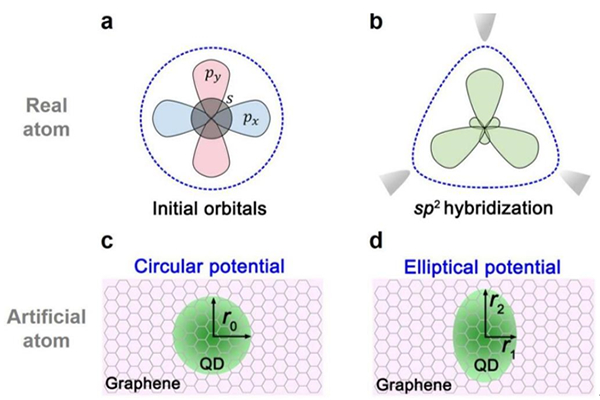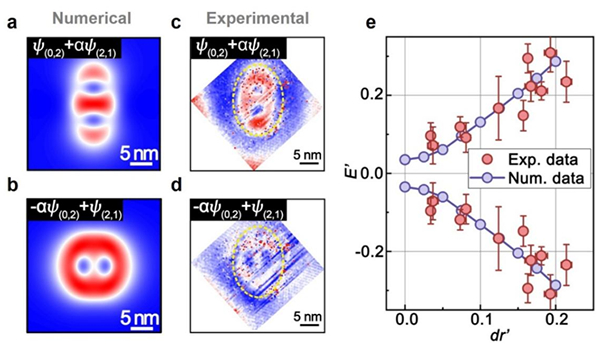Supported by the National Natural Science Foundation of China (Grant Nos. 12374034, 12141401), a collaborative research team led by Professor Qing-Feng Sun of International Center for Quantum Materials and School of Physics at Peking University, and Professor Lin He of School of Physics and Astronomy at Beijing Normal University, has demonstrated a novel approach to manipulating electronic states at the nanoscale and achieved orbital hybridization in graphene-based “artificial atoms” for the first time. Their work, titled “Orbital hybridization in graphene-based artificial atoms,” was published online in Nature on February 26, 2025 (https://doi.org/10.1038/s41586-025-08620-z).
In general, the properties of quantum confined systems are strongly influenced by the nature of the confined quasiparticles. While traditional studies have focused on the quantum confinement of non-interacting fermions (e.g., electrons) described by the Schrödinger equation, recent advances in two-dimensional materials, particularly graphene, have highlighted the unique physics of quantum confined Dirac fermions. When atoms assemble into matter, two fundamental processes occur: (1) chemical bonding through interatomic attractive forces, and (2) orbital hybridization, resulting from the anisotropy of intra-atomic potential fields. Although researchers have successfully simulated chemical bond formation, including bonding and antibonding states, in quantum dots through inter-dot coupling (“artificial atoms”), orbital hybridization in artificial structures has not been achieved.
To address this challenge, the collaborative research team innovatively proposed a new concept of orbital hybridization in artificial atoms, based on the physical essence of real atomic orbital hybridization. They revealed that the anisotropic potential field of artificial atoms can induce hybridization between different orbital confined states with energy degeneracy, and successfully achieved orbital hybridization of confined states in a graphene quantum dot system (Figure 1). Theoretical results (led by Professor Sun) show that when a circular quantum dot is deformed into an elliptical shape, s-orbitals and d-orbitals hybridize to form two new states, whose spatial distribution presents unique ‘θ’ and ‘inverted θ’ shape characteristics (Figure 2(a, b)). Experimental validation (led by Professor He) used an experimental method based on scanning tunneling microscopy (STM) tip manipulation technology to prepare quantum dots with controllable anisotropy, and directly observed the experimental evidence of orbital hybridization for the first time (Figure 2(c, d)). Further studies found that this hybridization phenomenon is the result of quantum superposition of collapsed states and whispering gallery states, which originates from the combined effect of Klein tunneling and boundary scattering. In addition, as the anisotropy of the quantum dot increases, the hybridization intensity significantly enhances, leading to a gradual increase in the energy splitting of the two hybridized states (Figure 2e).
This work offers a new perspective on the quantum phenomena in graphene quantum dots, and provides critical insights for the development of innovative graphene-based quantum devices.

Figure 1. (a) Schematic diagrams of unhybridized orbitals and (b) sp2 orbital hybridization in real atoms; The lower panels show schematic diagrams of (c) a circular potential field and (d) an elliptical potential field in artificial atoms, respectively.

Figure 2. (a, b) Numerically simulations of hybrid states (in the shapes of ‘θ’ and ‘inverted θ’); (c, d) Hybrid states observed in experiments; (e) The energy splitting of the hybrid states as the degree of anisotropy of the quantum dots increases.

Add: 83 Shuangqing Rd., Haidian District, Beijing, China
Postcode: 100085
Tel: 86-10-62327001
Fax: 86-10-62327004
E-mail: bic@niballiance.org
京ICP备05002826号 文保网安备1101080035号 Copyright 2017 NSFC, All Right Reserved